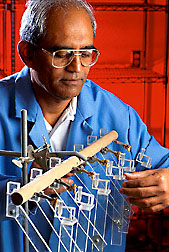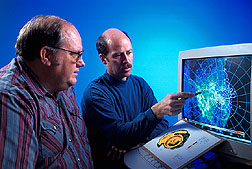Attracting & Tracking an Intractable Pest
|
|
Entomologist Peter D. Lingren (now retired) had a simple plan for keeping farmers' most damaging pest—the corn earworm—out of their corn and cottonfields. He would find out what adult corn earworm moths like to eat, attract them with it, and kill them with a deadly substitute.
In the South, corn earworm moths, Helicoverpa zea, feast on corn before they move on to damage cotton. Each year, these pests cost farmers about $2 billion in losses and control costs.
Lingren's push against the corn earworm began in 1987. That's when researchers in the ARS Areawide Pest Management Research Unit at College Station, Texas, began gathering information about the insects' taste in food and their capacity for flight. [See "Migratory Pests: Hit 'Em With All We've Got," Agricultural Research, December 1994, pp. 4-8.]
A Fatal Attraction
ARS entomologist Juan Lopez, Jr., and agricultural engineer Kenneth R. Beerwinkle are ushering Lingren's dream into its commercial development phase. They have applied for a patent on an attractant that can be used with a feeding stimulant and insecticide to lure both male and female moths of several insect species to their last meal.
"Female moths are the prime target because of their egg-laying and reproductive role," says Lopez. "But this attractant isn't based on a sex pheromone. Moths of both sexes are lured to an artificial aroma of night-blooming Gaura plants."
Once attracted, the moths begin feeding. The stimulant helps them pig-out on the toxic dish so that only a light serving—.01 percent, or 100 parts per million—of carbaryl, a commonly used household insecticide, is needed to kill them.
The attractant is the culmination of years of research data gathered by Lopez, Beerwinkle, and retired ARS chemist Ted N. Shaver. They investigated not only the moths' favorite foods, but also the chemical aromas, or volatiles, given off by flowers and their effect on feeding behavior.
Identifying these aromas was tedious. Beerwinkle and Shaver collected them in a jar from plant blooms. They looked for volatiles that were common to different plants. Searching for just the right scent, they placed hundreds of moths inside a Plexiglas chamber sectioned into tunnels. Each tunnel contained a cotton roll saturated with a different scent. An attractant was deemed a success if the moths followed the scent released by a cotton roll.
In a 1997 field study, Lopez gave corn earworm moths a lethal dish that killed 730 moths in a 54-foot cornrow. But not all of the insects that died from the toxic food were found intact.
"On the morning after treatment, we found wings without bodies, which we estimated to represent another 150 moths. Those insects were likely eaten by predators," says Lopez. "The second night after treatment, we found more dead moths."
Lopez and other ARS researchers at Charleston, South Carolina, and Ames, Iowa, have tested the attractant on melonworms, pickleworms, cabbage and soybean loopers, and on European corn borers that alone cause losses of $350 million each year.
The pickleworm damages pickling cucumbers. This crop often requires between six and eight applications of insecticide at costs ranging from $5 to $15 per acre, according to a North Carolina State extension specialist.
The Texas researchers are establishing a cooperative research and development agreement with an industry partner to help commercialize this type of feeding attractant for a wide range of agricultural insect pests.
Going a Little Batty
While some Helicoverpa moths feed on cotton after leaving southern corn, others travel north to ravage midwestern corn crops. In early June, billions of corn earworm moths emerge from the Lower Rio Grande Valley along the border of Texas and Mexico. These moths are known to fly as high as 10,000 feet and are often carried more than 250 miles per night by wind currents, according to ARS meteorologist John K. Westbrook, who is also in College Station.
To gobble up these airborne moths, researchers are looking to bats.
"The voracious appetite of Mexican free-tailed bats may be a valuable resource for farmers to help reduce populations of Helicoverpa moths," says Westbrook.
Corn earworm moths are one of the bats' favorite foods. A million bats can eat nearly 10 tons of insects in just one night, according to bat specialist Gary F. McCracken of the University of Tennessee. So the 20 million Mexican free-tailed bats living in Bracken Cave near San Antonio, Texas, could significantly reduce populations of corn earworm moths.
"About 30 minutes before sunset, you can hear adult bats leaving the cave on a mission to feed and bring back food to their young," says McCracken.
High-Tech Tracking
While weather specialists use the National Weather Service's Doppler radar system (NEXRAD) to detect precipitation, Westbrook uses it primarily to detect moth migration.
In a collaborative study with McCracken and Merlin Tuttle of Bat Conservation International, Westbrook used the system to detect the foraging flights of bats traveling toward concentrations of migrating Helicoverpa moths.
|
|
Westbrook attached radiomicrophones provided by McCracken to helium-filled balloons called tetroons. They listened to the audio signals transmitted while the tetroons drifted at an altitude of about 2,500 feet. The radiomicrophones picked up the high-frequency sounds of bats preying on moths. McCracken analyzed the content of bat feces, or guano, to confirm the consumption of corn earworm moths and other insects.
"With insect-detection radar, we could follow moths only to a range of a few miles," says Westbrook. "But the wide view of the NEXRAD Doppler radar system allows us to detect masses of moths over 60 miles away from a radar site, one of which is located in Brownsville, Texas. By tracking the insects, we can determine where they go when they leave Texas cornfields."
He envisions having a system by 2002 that could hand off data to other radar units, so that changes in insect populations could be measured within a pest management area with a diameter of 200 to 400 miles. This information could be used by individual corn farmers or a consortium of pest managers involved in areawide pest management.
Like firefighters putting out the "hot spots," the NEXRAD radar research may be used to develop time-critical maps to help control infestations over a large area. Pest advisories could alert growers in agricultural production areas downwind of infested locations.
"One of the strengths of this system is its ability to survey insects over brushland, dryland, and irrigated cropland," says James R. Coppedge, who leads the Areawide Pest Management Research Unit. This unit has one of the most active radar-entomology research programs in the world.—By Linda Cooke McGraw, Agricultural Research Service Information Staff.
The research described in this article is part of Integrated Crop Production and Protection Systems, an ARS National Program described on the World Wide Web at http://www.nps.ars.usda.gov/programs/cppvs.htm.
Juan Lopez, Jr., Kenneth R. Beerwinkle, John K. Westbrook, and James R. Coppedge are in the USDA-ARS Areawide Pest Management Research Unit, 2771 F&B Rd., College Station, TX 77845; phone (409) 260-9351, fax (409) 260-9386.
"Attracting & Tracking an Intractable Pest" was published in the May 1999 issue of Agricultural Research magazine.









